Wildlife Conservation

The Detroit Zoological Society helps save wildlife locally, nationally and internationally through a comprehensive program that includes:
- The care and rescue of animals that ultimately live at the Detroit Zoo and Belle Isle Nature Center. Their stories help to enhance conservation knowledge and action by the more than 1.6 million people who visit these facilities each year. Many animals under our care are also part of critical assurance populations to guard against extinction
- Numerous field research and conservation projects with amphibians, reptiles, birds, mammals and butterflies to study and conserve wild populations
- Support of other conservation organizations in the field as well as related Detroit Zoological Society education initiatives
- Response to environmental emergencies where our specially trained staff rescue and rehabilitate wildlife affected by disasters such as oil spills
-
Amphibian Conservation
Peruvian Rainforest Frogs
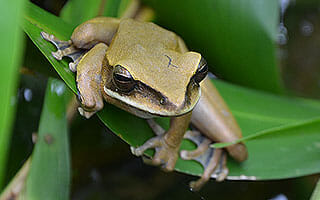 Since 2010, the Detroit Zoological Society has been involved in an assessment of amphibian populations in the Peruvian Amazon. The project includes field surveys to document species living in several sites along the Amazon and Napo rivers and testing for chytridiomycosis (chytrid Bd), an amphibian disease that is wiping out amphibian populations throughout South America and other parts of the world. People living in and around the study sites assist with conducting surveys so they can be a part of conserving their unique and fragile environmental heritage.
Since 2010, the Detroit Zoological Society has been involved in an assessment of amphibian populations in the Peruvian Amazon. The project includes field surveys to document species living in several sites along the Amazon and Napo rivers and testing for chytridiomycosis (chytrid Bd), an amphibian disease that is wiping out amphibian populations throughout South America and other parts of the world. People living in and around the study sites assist with conducting surveys so they can be a part of conserving their unique and fragile environmental heritage.Education is also a critical component of this project. Local people around the study sites learn that amphibians are important components of the ecosystem by eating insects and serving as food for other animals and that they are important bio-indicators that reflect the health of the environment. Education about amphibians also dispels myths about amphibians, such as the myth that humans can contract diseases from toads. Changing erroneous and harmful attitudes about animals is a critical step in saving amphibians and other wildlife.
Frog and Toad Species Survival Plans (SSPs)
The Detroit Zoological Society (DZS) and the award winning National Amphibian Conservation Center (NACC) are part of many SSP® programs. An SSP® is a program of the Association of Zoos and Aquariums which strives to manage and conserve ex situ (meaning “off-site”, or outside a species’ natural habitat) species populations in zoos and aquariums to ensure the sustainability of a healthy, genetically diverse, and demographically varied population. When suitable areas are available in situ (meaning “on-site”, or areas within the natural habitat of a species), individuals from SSP® programs can be released to the wild.
Wyoming Toad SSP®
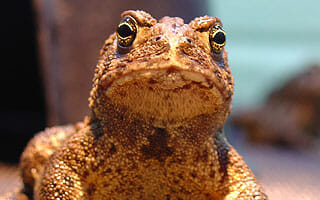
As part of the Wyoming Toad SSP®, the DZS breeds critically endangered Wyoming toads at the NACC. Since 2001, the DZS has released more than 9,400 Wyoming toads into the wild as tadpoles, toadlets and adults. This population is maintained in special bio-secure off-exhibit rooms of the NACC. In fact, more than half of the NACC is off-exhibit with bio-secure or disease free areas for breeding. Closed circuit televisions at the NACC provide a glimpse into this work being done behind the scenes. The NACC staff also participates in yearly monitoring of the Wyoming toad population at release sites in Wyoming.
Puerto Rican Crested Toad SSP®
 As part of the Puerto Rican Crested Toad SSP®, the DZS and the NACC breed critically endangered Puerto Rican crested toads. Since 2008, nearly 84,000 tadpoles have been released into the wild.
As part of the Puerto Rican Crested Toad SSP®, the DZS and the NACC breed critically endangered Puerto Rican crested toads. Since 2008, nearly 84,000 tadpoles have been released into the wild.
Dusky Gopher Frog SSP®
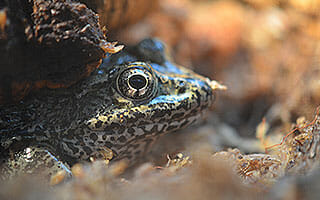 As part of the Dusky Gopher Frog SSP®, the DZS and the NACC maintain an “assurance population” of this critically endangered species. The captive population serves as insurance against extinction, and since 2018, more than 200 dusky gopher frogs from this assurance population were released to the wild. While at the Detroit Zoo, the dusky gopher frogs are maintained in special bio-secure behind-the-scenes rooms of the NACC. In fact, more than half of the NACC is behind-the-scenes with bio-secure or disease-free areas for breeding.
As part of the Dusky Gopher Frog SSP®, the DZS and the NACC maintain an “assurance population” of this critically endangered species. The captive population serves as insurance against extinction, and since 2018, more than 200 dusky gopher frogs from this assurance population were released to the wild. While at the Detroit Zoo, the dusky gopher frogs are maintained in special bio-secure behind-the-scenes rooms of the NACC. In fact, more than half of the NACC is behind-the-scenes with bio-secure or disease-free areas for breeding.
Panamanian Golden Frog SSP®
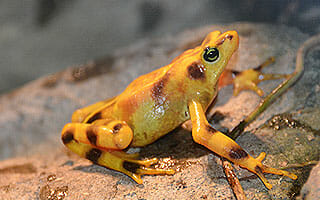 As part of the Panamanian Golden Frog SSP®, the DZS and the NACC maintain an “assurance population” of this critically endangered species. The captive population serves as insurance against extinction until the species can be adequately protected in the wild and suitable locations are found for release. Since 2015, DZS staff from the NACC have made several trips to Panama to assist with setting up research and breeding centers to facilitate future reintroductions of Panamanian golden frogs.
As part of the Panamanian Golden Frog SSP®, the DZS and the NACC maintain an “assurance population” of this critically endangered species. The captive population serves as insurance against extinction until the species can be adequately protected in the wild and suitable locations are found for release. Since 2015, DZS staff from the NACC have made several trips to Panama to assist with setting up research and breeding centers to facilitate future reintroductions of Panamanian golden frogs.
The Amphibian Survival Alliance
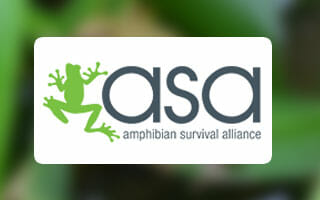 ASA is the world’s largest partnership for amphibian conservation. The Detroit Zoological Society provides financial support to ASA and is a Global Council member of the ASA. The ASA draws on cutting-edge research to protect amphibians and key habitats worldwide as well as educating and inspiring a global community to become a part of the amphibian conservation movement. Without immediate and coordinated action we stand to lose half of over 7,000 species of amphibians in our lifetimes.
ASA is the world’s largest partnership for amphibian conservation. The Detroit Zoological Society provides financial support to ASA and is a Global Council member of the ASA. The ASA draws on cutting-edge research to protect amphibians and key habitats worldwide as well as educating and inspiring a global community to become a part of the amphibian conservation movement. Without immediate and coordinated action we stand to lose half of over 7,000 species of amphibians in our lifetimes.
Mudpuppy
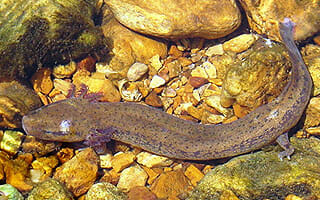 Since 2006, the Detroit Zoological Society has monitored mudpuppies in the Detroit River to track and better understand the population size and health of local mudpuppies. The aquatic salamanders are measured, weighed and implanted with computer chips for identification before being returned to the river. The Detroit River’s water chemistry is also tested and logged. The data gathered provide a valuable baseline for monitoring the health of the Detroit River ecosystem. Mudpuppies are important environmental watchdogs that visitors to the Detroit Zoo and the Belle Isle Nature Center can observe and learn about.
Since 2006, the Detroit Zoological Society has monitored mudpuppies in the Detroit River to track and better understand the population size and health of local mudpuppies. The aquatic salamanders are measured, weighed and implanted with computer chips for identification before being returned to the river. The Detroit River’s water chemistry is also tested and logged. The data gathered provide a valuable baseline for monitoring the health of the Detroit River ecosystem. Mudpuppies are important environmental watchdogs that visitors to the Detroit Zoo and the Belle Isle Nature Center can observe and learn about.
Striped Newts
 Striped newts are native to the southeastern United States. They have undergone significant population declines from habitat loss, and since 2017, the Detroit Zoological Society has partnered with the Florida Wildlife Commission, Georgia Department of Natural Resources, the Coastal Plains Institute, and several AZA institutions to rear striped newts for release in protected areas. Staff at the National Amphibian Conservation Center have raised more than 75 newts at the Detroit Zoo, where they will live for several months before being returned to protected areas in Florida and Georgia.
Striped newts are native to the southeastern United States. They have undergone significant population declines from habitat loss, and since 2017, the Detroit Zoological Society has partnered with the Florida Wildlife Commission, Georgia Department of Natural Resources, the Coastal Plains Institute, and several AZA institutions to rear striped newts for release in protected areas. Staff at the National Amphibian Conservation Center have raised more than 75 newts at the Detroit Zoo, where they will live for several months before being returned to protected areas in Florida and Georgia.
FrogWatch USA
Learn More and Register for FrogWatch FrogWatch USA is a national citizen science program through the Association of Zoos and Aquariums (AZA) for monitoring local frog and toad populations. The Amphibian staff of the Detroit Zoological Society train citizen scientists to collect data about Michigan frogs and toads by identifying their calls. These data are then included in the national AZA database as well as the Michigan Department of Natural Resources herp atlas to help monitor the distribution and population trends for frogs and toads. If you are interested in contributing to frog and toad conservation from your backyard to across Michigan, join the local monitoring team. Training opportunities occur every February and March.
FrogWatch USA is a national citizen science program through the Association of Zoos and Aquariums (AZA) for monitoring local frog and toad populations. The Amphibian staff of the Detroit Zoological Society train citizen scientists to collect data about Michigan frogs and toads by identifying their calls. These data are then included in the national AZA database as well as the Michigan Department of Natural Resources herp atlas to help monitor the distribution and population trends for frogs and toads. If you are interested in contributing to frog and toad conservation from your backyard to across Michigan, join the local monitoring team. Training opportunities occur every February and March. -
Bird Conservation
Great Lakes Piping Plover
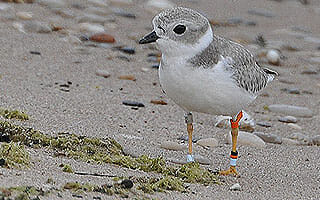 Piping plovers are tiny shorebirds that make shallow nests in the summer on flat, open, sandy beaches in northern Michigan – the same beaches that attract people, their pets and development. In 1986 there were only 17 nesting pairs of this endangered species remaining in the Great Lakes, and a federal recovery program was established by the United States Fish and Wildlife Service (USFWS). Scientists found that some of the plovers were abandoning their eggs, and they realized that salvaging these abandoned eggs could contribute significantly to the species’ recovery. Because of the Detroit Zoological Society’s (DZS) expertise in bird care and incubation, the DZS developed a captive rearing program to hatch out abandoned eggs and rear the tiny chicks until they can be released to join wild plovers. This “salvage rearing” is an important part of the federal recovery program for piping plovers.
Piping plovers are tiny shorebirds that make shallow nests in the summer on flat, open, sandy beaches in northern Michigan – the same beaches that attract people, their pets and development. In 1986 there were only 17 nesting pairs of this endangered species remaining in the Great Lakes, and a federal recovery program was established by the United States Fish and Wildlife Service (USFWS). Scientists found that some of the plovers were abandoning their eggs, and they realized that salvaging these abandoned eggs could contribute significantly to the species’ recovery. Because of the Detroit Zoological Society’s (DZS) expertise in bird care and incubation, the DZS developed a captive rearing program to hatch out abandoned eggs and rear the tiny chicks until they can be released to join wild plovers. This “salvage rearing” is an important part of the federal recovery program for piping plovers.Abandoned eggs are brought to a captive rearing facility at the University of Michigan’s Biological Station in Pellston, Mich. The DZS oversees the incubation and rearing programs and coordinates the involvement of bird care staff from the Detroit Zoo and other Association of Zoos and Aquarium (AZA) institutions who help monitor the eggs and care for the chicks after they hatch. The chicks are reared in pens on the beach to protect them from predators as they acclimate to living in the wild. Piping plovers are able to fly by the time they’re four weeks old, and at that point they’re released at sites with adult plovers and their nearly grown chicks. They quickly acclimate into these groups and join them for the fall migration to the southern U.S., where they will spend the winter. The Great Lakes population of piping plovers is now about 80 breeding pairs, and the captive-reared birds and their descendants have made a significant contribution to this small population. The DZS piping plover program was recognized by the AZA with a Significant Achievement Award for North American Conservation in 2009. More information about the work being done by DZS and its collaborators can be found on the Great Lakes Piping Plover Recovery Effort website, Facebook, and Twitter.
Black Tern
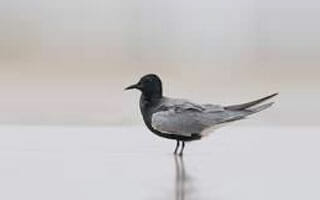 The black tern is considered a species of Special Concern by the Michigan Department of Natural Resources (MDNR). St. Clair Flats on Harsens Island is one of the most significant Important Bird Areas in Michigan, representing the world’s largest freshwater delta and hosting Michigan’s largest remaining black tern colony. Black terns have experienced drastic range-wide declines in recent decades, including in Michigan, but the cause of these declines is not well understood. Since 2012, the Detroit Zoological Society has assisted the Detroit Audubon, Great Lakes Audubon and the MDNR to study the nesting success of this species on St. Clair Flats in order to begin to understand whether conservation work is needed on their breeding colonies in Michigan or at the wintering grounds in the tropical seas west of Central and South America.
The black tern is considered a species of Special Concern by the Michigan Department of Natural Resources (MDNR). St. Clair Flats on Harsens Island is one of the most significant Important Bird Areas in Michigan, representing the world’s largest freshwater delta and hosting Michigan’s largest remaining black tern colony. Black terns have experienced drastic range-wide declines in recent decades, including in Michigan, but the cause of these declines is not well understood. Since 2012, the Detroit Zoological Society has assisted the Detroit Audubon, Great Lakes Audubon and the MDNR to study the nesting success of this species on St. Clair Flats in order to begin to understand whether conservation work is needed on their breeding colonies in Michigan or at the wintering grounds in the tropical seas west of Central and South America.
Osprey
 In the 1950s and 1960s, populations of osprey – fish-eating birds of prey – were decimated by the harmful effects of DDT pesticides on breeding success. The Detroit Zoological Society has worked with the volunteer organization Osprey Watch of Southeast Michigan, the MDNR and Huron Clinton Metropolitan Authority (HCMA) to help re-establish osprey to southeast Michigan. Osprey chicks from northern Michigan have been transferred to HCMA’s Kensington and Stony Creek Metroparks to establish osprey populations in these areas. Five-week-old male chicks from northern Michigan are taken from the nests in which they hatched to large enclosed boxes (called hacking towers). Males are chosen because they normally return to their fledging sites as adults to nest and rear offspring. Staff from the DZS supervise the rearing of chicks until they area ready to begin to fly. As they near this fledging stage, the box is opened and they quickly learn to fly and to catch fish.
In the 1950s and 1960s, populations of osprey – fish-eating birds of prey – were decimated by the harmful effects of DDT pesticides on breeding success. The Detroit Zoological Society has worked with the volunteer organization Osprey Watch of Southeast Michigan, the MDNR and Huron Clinton Metropolitan Authority (HCMA) to help re-establish osprey to southeast Michigan. Osprey chicks from northern Michigan have been transferred to HCMA’s Kensington and Stony Creek Metroparks to establish osprey populations in these areas. Five-week-old male chicks from northern Michigan are taken from the nests in which they hatched to large enclosed boxes (called hacking towers). Males are chosen because they normally return to their fledging sites as adults to nest and rear offspring. Staff from the DZS supervise the rearing of chicks until they area ready to begin to fly. As they near this fledging stage, the box is opened and they quickly learn to fly and to catch fish.Since 2013, DZS has also helped with the banding of osprey chicks, conducting DNA testing to determine the sex of chicks and attaching satellite transmitters (18 since 2013) to track their movements. These transmitters have shown that the birds migrate from Michigan to South America via the Caribbean (learn more: http://michiganosprey.org). Male ospreys have returned from the southern migratory areas with new mates in tow and nesting sites have expanded outside SE Michigan so transplanting ospreys from other areas is no longer part of the project. The DZS now coordinates the monitoring of osprey nests in southern and central Michigan to determine hatching success.
Peregrine Falcon
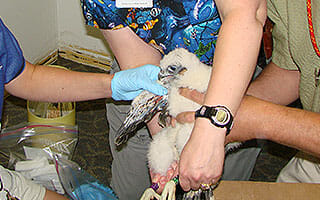
As with ospreys, peregrine falcon populations were decimated in the 1950s and 1960s by the harmful effects of DDT pesticides on breeding success. The last recorded peregrine nest in Michigan was in 1957. After DDT use was banned, peregrines were reintroduced to Michigan starting in the 1970s. This recovery has gone well especially in urban areas like Detroit where peregrines feed largely on pigeons that they can catch with high speed dives of up to 180 mph. The Detroit Zoological Society has worked with the Michigan Department of Natural Resources (MDNR) Natural Heritage Program for several years to band falcons in Detroit to help return this charismatic part of the city’s urban ecology as part of a wider effort to band nesting peregrines in urban areas in the eastern U.S. A pair of peregrine falcons took up residence in June 2016 on one of the most visible landmarks in the region, the Detroit Zoo water tower at Woodward Avenue and 10 Mile Road in Royal Oak. Zoo staff placed a specially designed nestbox in 2017 and different pairs of falcons have fledged chicks between 2017-2022.
Black-crowned Night Heron
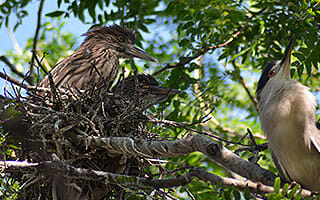 The Detroit Zoo is home to a large colony of wild black-crowned night herons that nest in various areas of the Zoo. DZS bird staff monitors the success of this colony and has begun a long-term population study where chicks are banded with colored bands so individual birds can be identified and monitored.
The Detroit Zoo is home to a large colony of wild black-crowned night herons that nest in various areas of the Zoo. DZS bird staff monitors the success of this colony and has begun a long-term population study where chicks are banded with colored bands so individual birds can be identified and monitored.
Trumpeter Swan
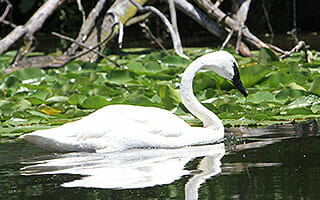 Trumpeter swans are endangered in the Great Lakes primarily because they are outcompeted by mute swans which were introduced from Europe and are less sensitive to human disturbance. The Detroit Zoological Society (DZS) worked with the Michigan Department of Natural Resources (MDNR) and Michigan State University’s Kellogg Biological Station from 1985 to 2006 to reintroduce trumpeter swans to northern Michigan. DZS raised 66 trumpeter swan cygnets at the Detroit Zoo and the former Belle Isle Zoo for release to sites in northern Michigan.
Trumpeter swans are endangered in the Great Lakes primarily because they are outcompeted by mute swans which were introduced from Europe and are less sensitive to human disturbance. The Detroit Zoological Society (DZS) worked with the Michigan Department of Natural Resources (MDNR) and Michigan State University’s Kellogg Biological Station from 1985 to 2006 to reintroduce trumpeter swans to northern Michigan. DZS raised 66 trumpeter swan cygnets at the Detroit Zoo and the former Belle Isle Zoo for release to sites in northern Michigan.
Falklands Conservation
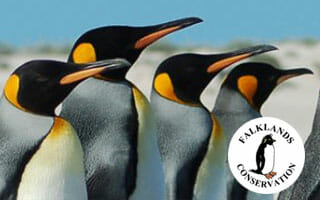 The Falkland Islands (Las Malvinas) off the southern coast of Argentina are a critical habitat for penguins and contain the largest breeding populations of gentoo and southern rockhopper penguins (about 100,000 and 200,000 breeding pairs, respectively). The Detroit Zoological Society (DZS) has funded the work of Falklands Conservation (FC), an organization which monitors and conducts research on the penguins and other wildlife at several island sites. This research helps to conserve penguin species at the Detroit Zoo’s Polk Penguin Conservation Center including king penguins, southern rockhopper penguins, gentoo penguins, and macaroni penguins. For example, some of the research uses satellite tracking and geo-locators to identify critical winter feeding areas for king penguins and southern rockhopper penguins. In 2016, 2017 and 2018, the DZS and FC collaborated on expeditions to several remote islands, using drones to more effectively conduct population surveys and document habitat conditions. In 2018, the collaboration expanded, and a long-term project was initiated to assess the health and welfare of gentoo and rockhopper penguins at two sites: one that is more remote and another that is more impacted by human activity such as oil extraction. The DZS and FC are hoping to clarify the potential impacts this human activity is having on the health and welfare of the penguins. These impacts may be different for the two penguin species because they have dissimilar ranging behavior: gentoos remain near the Falklands year round while rockhoppers migrate up to several hundred miles toward South America.
The Falkland Islands (Las Malvinas) off the southern coast of Argentina are a critical habitat for penguins and contain the largest breeding populations of gentoo and southern rockhopper penguins (about 100,000 and 200,000 breeding pairs, respectively). The Detroit Zoological Society (DZS) has funded the work of Falklands Conservation (FC), an organization which monitors and conducts research on the penguins and other wildlife at several island sites. This research helps to conserve penguin species at the Detroit Zoo’s Polk Penguin Conservation Center including king penguins, southern rockhopper penguins, gentoo penguins, and macaroni penguins. For example, some of the research uses satellite tracking and geo-locators to identify critical winter feeding areas for king penguins and southern rockhopper penguins. In 2016, 2017 and 2018, the DZS and FC collaborated on expeditions to several remote islands, using drones to more effectively conduct population surveys and document habitat conditions. In 2018, the collaboration expanded, and a long-term project was initiated to assess the health and welfare of gentoo and rockhopper penguins at two sites: one that is more remote and another that is more impacted by human activity such as oil extraction. The DZS and FC are hoping to clarify the potential impacts this human activity is having on the health and welfare of the penguins. These impacts may be different for the two penguin species because they have dissimilar ranging behavior: gentoos remain near the Falklands year round while rockhoppers migrate up to several hundred miles toward South America.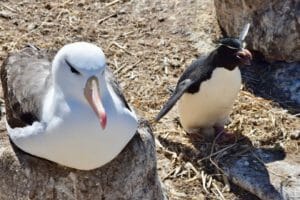
Black-browed albatross and southern rockhopper penguin

Drone’s-eye view of colonies with southern rockhopper penguins and black-browed albatross
Center for Ecosystem Sentinels
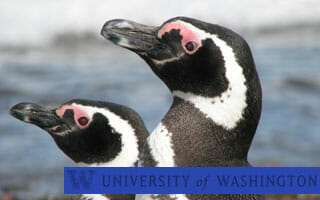 The Detroit Zoological Society provides funds to support the Center for Ecosystem Sentinels research on Magellanic penguins in Argentina and Galapagos penguins of the Galapagos Islands off the coast of Ecuador. These temperate penguin species – marine sentinels for southern oceans – demonstrate that new challenges are confronting their populations. For example, The Center for Penguins as Ocean Sentinels has demonstrated that Magellanic penguins are swimming 36 miles farther north from their nests during incubation than they did a decade ago. This very likely reflects shifts in prey in response to climate change and reductions in prey abundance caused by commercial fishing. The Center has also shown that increased rain has adversely affected the breeding success of Magellenic penguins. Furthermore, the Center has documented that the Galapagos penguin population has declined by about 75% since 1972 because of variations in the surface temperatures of the eastern Pacific Ocean that are increasing in strength and frequency. The warm temperature cycles are known as El Niños and they are particularly difficult for Galapagos penguins. The current Galapagos penguin population may be as low as 1,500 individuals making them the rarest of all penguin species.
The Detroit Zoological Society provides funds to support the Center for Ecosystem Sentinels research on Magellanic penguins in Argentina and Galapagos penguins of the Galapagos Islands off the coast of Ecuador. These temperate penguin species – marine sentinels for southern oceans – demonstrate that new challenges are confronting their populations. For example, The Center for Penguins as Ocean Sentinels has demonstrated that Magellanic penguins are swimming 36 miles farther north from their nests during incubation than they did a decade ago. This very likely reflects shifts in prey in response to climate change and reductions in prey abundance caused by commercial fishing. The Center has also shown that increased rain has adversely affected the breeding success of Magellenic penguins. Furthermore, the Center has documented that the Galapagos penguin population has declined by about 75% since 1972 because of variations in the surface temperatures of the eastern Pacific Ocean that are increasing in strength and frequency. The warm temperature cycles are known as El Niños and they are particularly difficult for Galapagos penguins. The current Galapagos penguin population may be as low as 1,500 individuals making them the rarest of all penguin species.
Bird Collisions
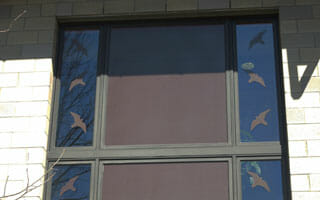 A bird collision is a phenomenon that occurs when a wild bird flies into a window and stuns themselves, many of the collision victims die.. The glass appears invisible to the bird, as it has a different visual system than a human. An estimated 253 million birds in the U.S. are killed from these collisions each year, according to the American Bird Conservancy.
A bird collision is a phenomenon that occurs when a wild bird flies into a window and stuns themselves, many of the collision victims die.. The glass appears invisible to the bird, as it has a different visual system than a human. An estimated 253 million birds in the U.S. are killed from these collisions each year, according to the American Bird Conservancy.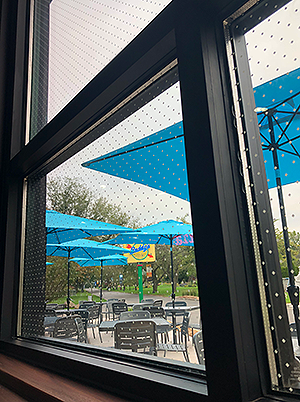 The DZS has taken preventative measures to improve the welfare of songbirds and prevent window collisions by applying window film and window dots to areas being tracked for collisions. DZS has also installed bird-safe glass in many areas of the Zoo. Members of the community can do their part to prevent bird collisions by turning off lights at night in tall buildings and putting up bird silhouettes, reflective tape or special film on windows to reduce the outside reflection, allowing birds to see the window as a barrier.
The DZS has taken preventative measures to improve the welfare of songbirds and prevent window collisions by applying window film and window dots to areas being tracked for collisions. DZS has also installed bird-safe glass in many areas of the Zoo. Members of the community can do their part to prevent bird collisions by turning off lights at night in tall buildings and putting up bird silhouettes, reflective tape or special film on windows to reduce the outside reflection, allowing birds to see the window as a barrier.
State of the World’s Birds Report
One in eight bird species is in danger of extinction. Learn about the current state of birds in nature and what is being done to protect wild bird populations in the 2022 State of the Birds World’s Birds Report.
-
Mammal Conservation
Isle Royale Wolves
 The DZS provides support to the Isle Royale wolf study at Michigan Tech University, and assists with field work on the Moosewatch expeditions. In the summers of 2016, 2017 and 2018, the DZS led teams of Moosewatch researchers to explore the backcountry of Isle Royale for moose skeletons. Moose are the primary prey for wolves on Isle Royale, and the Moosewatch program has studied the dynamics of the wolf and moose populations for more than 50 years in the longest continuous study of a predator-prey system. Once a moose skeleton is found, the timing of death is estimated, and the bones are examined to learn more about the cause of death. Chewed bones and widely dispersed leg bones suggest wolves may be to blame. The wolf population on Isle Royale has declined over the last several years to only two individuals because ice bridges that link Isle Royale with the mainland do not form as often as the climate has warmed. As a result, the moose population has exploded to the detriment of the Isle Royale ecosystem. To counteract this, additional wolves from the mainland were transferred to Isle Royale in the fall of 2018 to help the wolf population and the ecosystem recover.
The DZS provides support to the Isle Royale wolf study at Michigan Tech University, and assists with field work on the Moosewatch expeditions. In the summers of 2016, 2017 and 2018, the DZS led teams of Moosewatch researchers to explore the backcountry of Isle Royale for moose skeletons. Moose are the primary prey for wolves on Isle Royale, and the Moosewatch program has studied the dynamics of the wolf and moose populations for more than 50 years in the longest continuous study of a predator-prey system. Once a moose skeleton is found, the timing of death is estimated, and the bones are examined to learn more about the cause of death. Chewed bones and widely dispersed leg bones suggest wolves may be to blame. The wolf population on Isle Royale has declined over the last several years to only two individuals because ice bridges that link Isle Royale with the mainland do not form as often as the climate has warmed. As a result, the moose population has exploded to the detriment of the Isle Royale ecosystem. To counteract this, additional wolves from the mainland were transferred to Isle Royale in the fall of 2018 to help the wolf population and the ecosystem recover.
Eurasian Otters in Armenia
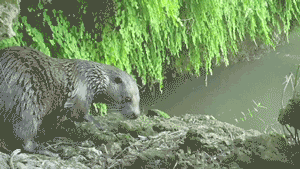 The DZS is working to conserve Eurasian otters in Armenia, a small country between the Black and Caspian seas in southwest Asia. Despite its small size, Armenia is important to wildlife conservation because it is part of the Greater Caucasus Mountains biodiversity hotspot. Eurasian otters are a vital part of the Armenian ecosystem because they can be indicators of healthy rivers and streams. Otters are considered endangered in Armenia, but there is little current information on their status. The DZS is conducting sign surveys for otter feces and feeding remains as well as using trail cameras to determine the status of otters; initial fieldwork conducted since 2018 suggests they have recovered in much of central, southern and northern Armenia as demonstrated by one of our trail cameras above. The DZS also received reports of human-otter conflict due to otters eating fish out of fish farm ponds, and is investigating ways to reduce this conflict.
The DZS is working to conserve Eurasian otters in Armenia, a small country between the Black and Caspian seas in southwest Asia. Despite its small size, Armenia is important to wildlife conservation because it is part of the Greater Caucasus Mountains biodiversity hotspot. Eurasian otters are a vital part of the Armenian ecosystem because they can be indicators of healthy rivers and streams. Otters are considered endangered in Armenia, but there is little current information on their status. The DZS is conducting sign surveys for otter feces and feeding remains as well as using trail cameras to determine the status of otters; initial fieldwork conducted since 2018 suggests they have recovered in much of central, southern and northern Armenia as demonstrated by one of our trail cameras above. The DZS also received reports of human-otter conflict due to otters eating fish out of fish farm ponds, and is investigating ways to reduce this conflict.
Snow Leopard/Red Panda
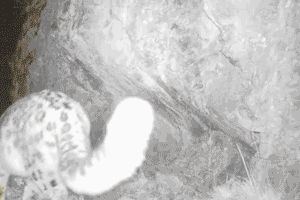 The Detroit Zoological Society (DZS) collaborated with the Xinjiang Institute of Zoology to study snow leopards in the Tienshan Mountains of Xinjiang province in northwest China. Trail cameras triggered by motion and heat demonstrated several important areas for snow leopards as shown by the video below, and we applied for protected area status with the provincial and national governments to limit human impacts in these areas. The DZS now collaborates with the Jane Goodall Institute Nepal and the National Trust for Nature Conservation to study and conserve snow leopards, red pandas and other alpine fauna in Nepal. This work also uses trail cameras to remotely monitor snow leopards and their prey as well as red pandas. Herders are also interviewed to learn more about human-wildlife conflict from snow leopard predation of livestock and to find ways to reduce this conflict.
The Detroit Zoological Society (DZS) collaborated with the Xinjiang Institute of Zoology to study snow leopards in the Tienshan Mountains of Xinjiang province in northwest China. Trail cameras triggered by motion and heat demonstrated several important areas for snow leopards as shown by the video below, and we applied for protected area status with the provincial and national governments to limit human impacts in these areas. The DZS now collaborates with the Jane Goodall Institute Nepal and the National Trust for Nature Conservation to study and conserve snow leopards, red pandas and other alpine fauna in Nepal. This work also uses trail cameras to remotely monitor snow leopards and their prey as well as red pandas. Herders are also interviewed to learn more about human-wildlife conflict from snow leopard predation of livestock and to find ways to reduce this conflict.
Snow Leopard Trust
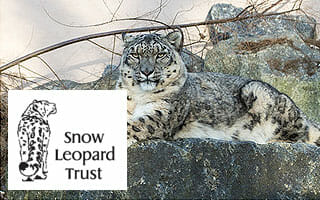 The Detroit Zoological Society further enhances snow leopard conservation by providing financial support to the Snow Leopard Trust (SLT). The SLT strives to create sustainable conservation programs that benefit snow leopards and local communities that share the mountain habitats. It works in five of the 12 countries that have snow leopards (China, India, Mongolia, Pakistan, and Kyrgyzstan) where it has established programs to compensate herders for livestock killed by snow leopards and to generate income for herders involved in snow leopard conservation programs. These programs involve snow leopard monitoring and removing livestock from certain areas to increase populations of natural snow leopard prey such as blue sheep.
The Detroit Zoological Society further enhances snow leopard conservation by providing financial support to the Snow Leopard Trust (SLT). The SLT strives to create sustainable conservation programs that benefit snow leopards and local communities that share the mountain habitats. It works in five of the 12 countries that have snow leopards (China, India, Mongolia, Pakistan, and Kyrgyzstan) where it has established programs to compensate herders for livestock killed by snow leopards and to generate income for herders involved in snow leopard conservation programs. These programs involve snow leopard monitoring and removing livestock from certain areas to increase populations of natural snow leopard prey such as blue sheep.
Polar Bear/Grizzly Bear
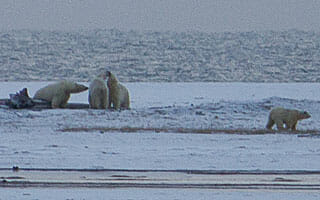 The Detroit Zoological Society collaborates with the United States Geological Survey, the United States Fish and Wildlife Service, the Arctic National Wildlife Refuge and the village of Kaktovik in field research about the overlap in resource use between polar bears and grizzly bears on the north slope of Alaska. Such overlap is increasing as both bear species shift their ranges in response to climate change. For example, decreasing sea ice forces polar bears to spend more time onshore while the berries and prey of grizzlies are shifting north with warmer temperatures. The Inupiat population at Kaktovik hunts three bowhead whales per year for subsistence, and both bear species have been observed scavenging on the whale carcasses. This scavenging will likely become more and more important for both bear species in the future. Information on population status and habitat use is urgently needed to better understand how polar bears are faring as a result of climate change and increasing human use of bear habitat.
The Detroit Zoological Society collaborates with the United States Geological Survey, the United States Fish and Wildlife Service, the Arctic National Wildlife Refuge and the village of Kaktovik in field research about the overlap in resource use between polar bears and grizzly bears on the north slope of Alaska. Such overlap is increasing as both bear species shift their ranges in response to climate change. For example, decreasing sea ice forces polar bears to spend more time onshore while the berries and prey of grizzlies are shifting north with warmer temperatures. The Inupiat population at Kaktovik hunts three bowhead whales per year for subsistence, and both bear species have been observed scavenging on the whale carcasses. This scavenging will likely become more and more important for both bear species in the future. Information on population status and habitat use is urgently needed to better understand how polar bears are faring as a result of climate change and increasing human use of bear habitat.
Grevy’s Zebra Trust
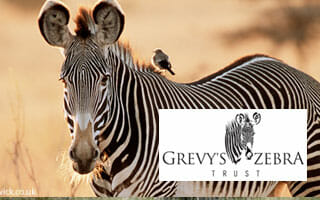 The Detroit Zoological Society provides financial support for the Grevy’s Zebra Trust (GZT) to help conserve Grevy’s zebras. The fates of Grevy’s zebra and human livelihoods are inextricably linked to the fragile ecosystem that they inhabit. As a result, GZT works closely with the community rangelands of Kenya and Ethiopia to monitor and protect endangered Grevy’s zebras. GZT has education and awareness programs for pastoral children as well as rangeland rehabilitation programs that focus on planned livestock grazing. The success and sustainability of Grevy’s zebra conservation is thus critically dependent on having the commitment of communities living across its range. In 2012, GZT was awarded the Association of Zoos & Aquariums (AZA) International Conservation Award.
The Detroit Zoological Society provides financial support for the Grevy’s Zebra Trust (GZT) to help conserve Grevy’s zebras. The fates of Grevy’s zebra and human livelihoods are inextricably linked to the fragile ecosystem that they inhabit. As a result, GZT works closely with the community rangelands of Kenya and Ethiopia to monitor and protect endangered Grevy’s zebras. GZT has education and awareness programs for pastoral children as well as rangeland rehabilitation programs that focus on planned livestock grazing. The success and sustainability of Grevy’s zebra conservation is thus critically dependent on having the commitment of communities living across its range. In 2012, GZT was awarded the Association of Zoos & Aquariums (AZA) International Conservation Award.
Jane Goodall Institute
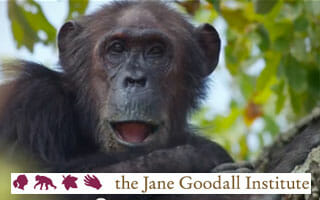 The Detroit Zoological Society provides financial support for the Jane Goodall Institute (JGI) which builds on Dr. Goodall’s ground-breaking scientific work with chimpanzees and her humanitarian vision. JGI is a global nonprofit that empowers people to make a difference for all living things. Specifically, JGI seeks to:
The Detroit Zoological Society provides financial support for the Jane Goodall Institute (JGI) which builds on Dr. Goodall’s ground-breaking scientific work with chimpanzees and her humanitarian vision. JGI is a global nonprofit that empowers people to make a difference for all living things. Specifically, JGI seeks to:
1. improve global understanding and treatment of chimpanzees and other great apes through research, public education and advocacy;
2. contribute to the preservation of great apes and their habitats by combining conservation with education and promotion of sustainable livelihoods in local communities; and
3. create a worldwide network of young people who have learned to care deeply for their human community, for all animals and for the environment, and who will take responsible action to care for them.
Ngogo Chimpanzee Project
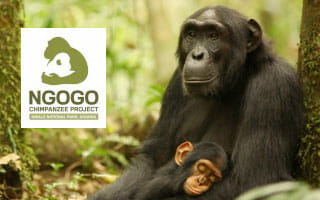 The Detroit Zoological Society also supports the conservation work of the Ngogo Chimpanzee Project (NCP) at Kibale National Park, Uganda. Kibale contains the largest population of chimpanzees in Uganda and one of the largest in East Africa, making it one of the few remaining strongholds for chimpanzees in the wild. The main threat to chimpanzees in Kibale is poaching, which has increased in frequency alongside increases in local human populations. Although there are local taboos against eating chimpanzees, they get caught in the snares set by poachers to catch other wildlife so often that it is estimated that fully one-third of the chimpanzees within the park have snare-related injuries. Those chimpanzees who are able to free themselves usually cannot remove the snares entirely, and over time, the wire or nylon material becomes wrapped tighter and tighter around their fingers, hands, or feet, causing pain and infection, and often leading to the loss of the snared body parts entirely or even death. In an effort to protect chimpanzees and other animals in Kibale, the NCP employs a team of local people who patrol the park for snares and signs of poaching activity working closely with local Uganda Wildlife Authority law enforcement officers who receive confiscated snares and GPS coordinates when poaching activity is encountered.
The Detroit Zoological Society also supports the conservation work of the Ngogo Chimpanzee Project (NCP) at Kibale National Park, Uganda. Kibale contains the largest population of chimpanzees in Uganda and one of the largest in East Africa, making it one of the few remaining strongholds for chimpanzees in the wild. The main threat to chimpanzees in Kibale is poaching, which has increased in frequency alongside increases in local human populations. Although there are local taboos against eating chimpanzees, they get caught in the snares set by poachers to catch other wildlife so often that it is estimated that fully one-third of the chimpanzees within the park have snare-related injuries. Those chimpanzees who are able to free themselves usually cannot remove the snares entirely, and over time, the wire or nylon material becomes wrapped tighter and tighter around their fingers, hands, or feet, causing pain and infection, and often leading to the loss of the snared body parts entirely or even death. In an effort to protect chimpanzees and other animals in Kibale, the NCP employs a team of local people who patrol the park for snares and signs of poaching activity working closely with local Uganda Wildlife Authority law enforcement officers who receive confiscated snares and GPS coordinates when poaching activity is encountered.
Gorilla Rehabilitation And Conservation Education
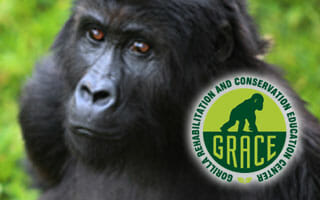
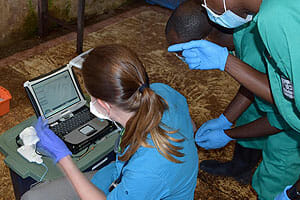
The Detroit Zoological Society has partnered with the Gorilla Rehabilitation and Conservation Education (GRACE) Center to conserve Grauer’s gorillas or Eastern lowland gorillas. Grauer’s gorillas are closely related to the western lowland gorillas at the Detroit Zoo but they are much more endangered. Grauer’s gorillas are hunted for their meat and sold as pets and further threatened by the civil unrest in the Democratic Republic of Congo (DRC). GRACE’s mission is to provide the best facilities and care for rescued Grauer’s gorillas in the DRC while working alongside local communities to ensure gorilla survival in the wild. In 2015, DZS veterinary staff traveled to GRACE to conduct health assessments of the gorillas and train local veterinarians, and in 2016, DZS education staff provided training in humane education.
Ape Taxon Advisory Group (TAG)
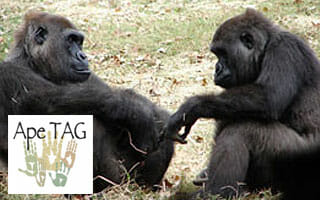 The Taxon Advisory Groups (TAGs) of the Association of Zoos & Aquariums have a mission to examine the conservation needs of an entire taxa or group of animals. The Ape TAG Conservation Initiative represents a collective effort by the Detroit Zoo and other zoos to help conserve wild populations of apes. Launched in early 2010, the primary aim of the Conservation Initiative is to increase the amount and duration of zoo support for ape conservation.
The Taxon Advisory Groups (TAGs) of the Association of Zoos & Aquariums have a mission to examine the conservation needs of an entire taxa or group of animals. The Ape TAG Conservation Initiative represents a collective effort by the Detroit Zoo and other zoos to help conserve wild populations of apes. Launched in early 2010, the primary aim of the Conservation Initiative is to increase the amount and duration of zoo support for ape conservation.
Amboseli Trust for Elephants
 The Detroit Zoological Society supports African elephant conservation through its long term commitment to the Amboseli Trust for Elephants which initiates, supports and ensures the continuation of key elephant research projects across the African continent. The Trust is developed on the work of elephant expert Cynthia Moss who has studied and protected the elephants of Kenya’s Amboseli National Park for over 35 years. In addition, DZS added its voice to the growing chorus of conservationists, policy makers and caring individuals who are demanding an end to the slaughter of Africa’s elephants. DZS supports the Wildlife Conservation Society’s 96 Elephants campaign to halt the sale of ivory, bolster elephant protection and teach people about the link between ivory and poaching.
The Detroit Zoological Society supports African elephant conservation through its long term commitment to the Amboseli Trust for Elephants which initiates, supports and ensures the continuation of key elephant research projects across the African continent. The Trust is developed on the work of elephant expert Cynthia Moss who has studied and protected the elephants of Kenya’s Amboseli National Park for over 35 years. In addition, DZS added its voice to the growing chorus of conservationists, policy makers and caring individuals who are demanding an end to the slaughter of Africa’s elephants. DZS supports the Wildlife Conservation Society’s 96 Elephants campaign to halt the sale of ivory, bolster elephant protection and teach people about the link between ivory and poaching.
Chipangali Wildlife Trust
 The Detroit Zoological Society supports important research conducted by Chipangali Wildlife Trust’s research staff on the duikers (forest antelopes) of sub-Saharan Africa and on leopards, cheetahs and brown hyenas in Zimbabwe as well as the conservation and care of animals at Chipangali Wildlife Orphanage in Zimbabwe.
The Detroit Zoological Society supports important research conducted by Chipangali Wildlife Trust’s research staff on the duikers (forest antelopes) of sub-Saharan Africa and on leopards, cheetahs and brown hyenas in Zimbabwe as well as the conservation and care of animals at Chipangali Wildlife Orphanage in Zimbabwe. -
Reptile Conservation
Blanding’s Turtle
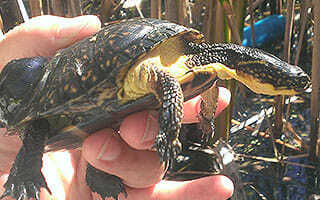 Since 2011, the Detroit Zoological Society staff has worked with the United States Fish and Wildlife Service, the Shiawassee National Wildlife Refuge (NWR), and students at University of Michigan Flint to help conserve Blanding’s turtles which are endangered and listed as a species of Special Concern by the Michigan Department of Natural Resources. At Shiawassee NWR, few young turtles were observed in the population, and it was realized that increasing numbers of raccoons were eating turtle eggs and young. DZS and its partners initiated a head-start program for young Blanding’s turtles. Eggs collected from nests at Shiawassee NWR are hatched at the Detroit Zoo, and young Blanding’s turtles are raised at the Zoo until they are old enough to be less susceptible to raccoon predation. More than 100 turtles have been released since 2012. UM Flint graduate students attach radio-tracking devices to the turtles to locate them and assess the success of the head-starting program. The DZS’s Center for Zoo and Aquarium Animal Welfare and Ethics is conducting a study on turtle personalities as an aspect of compassionate conservation. Compassionate conservation fully considers the needs of individual animals in conservation research and practice. This study considers how a turtle’s shyness or boldness, for example, may affect survival.
Since 2011, the Detroit Zoological Society staff has worked with the United States Fish and Wildlife Service, the Shiawassee National Wildlife Refuge (NWR), and students at University of Michigan Flint to help conserve Blanding’s turtles which are endangered and listed as a species of Special Concern by the Michigan Department of Natural Resources. At Shiawassee NWR, few young turtles were observed in the population, and it was realized that increasing numbers of raccoons were eating turtle eggs and young. DZS and its partners initiated a head-start program for young Blanding’s turtles. Eggs collected from nests at Shiawassee NWR are hatched at the Detroit Zoo, and young Blanding’s turtles are raised at the Zoo until they are old enough to be less susceptible to raccoon predation. More than 100 turtles have been released since 2012. UM Flint graduate students attach radio-tracking devices to the turtles to locate them and assess the success of the head-starting program. The DZS’s Center for Zoo and Aquarium Animal Welfare and Ethics is conducting a study on turtle personalities as an aspect of compassionate conservation. Compassionate conservation fully considers the needs of individual animals in conservation research and practice. This study considers how a turtle’s shyness or boldness, for example, may affect survival.
Reptile Species Survival Plan® (SSP) Programs
 The Detroit Zoological Society (DZS) and the award-winning Holden Reptile Conservation Center (HRCC) are part of many SSP® programs. An SSP® is a program of the Association of Zoos & Aquariums which strives to manage and conserve ex situ (meaning “off-site”, or outside a species’ natural habitat) species populations in zoos and aquariums to ensure the sustainability of a healthy, genetically diverse, and demographically varied population. When suitable areas are available in situ (meaning “on-site”, or areas within the natural habitat of a species), individuals from SSP® programs can be released to the wild.
The Detroit Zoological Society (DZS) and the award-winning Holden Reptile Conservation Center (HRCC) are part of many SSP® programs. An SSP® is a program of the Association of Zoos & Aquariums which strives to manage and conserve ex situ (meaning “off-site”, or outside a species’ natural habitat) species populations in zoos and aquariums to ensure the sustainability of a healthy, genetically diverse, and demographically varied population. When suitable areas are available in situ (meaning “on-site”, or areas within the natural habitat of a species), individuals from SSP® programs can be released to the wild.
McCord’s Box Turtle SSP®
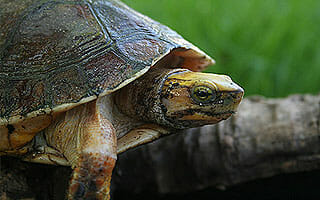 The McCord’s box turtle is a critically endangered species from China. McCord’s box turtles have been hunted for meat, traditional medicine and a worldwide trade in turtles as pets. These factors, coupled with habitat loss due to the expansion of human populations, have pushed them to the brink of extinction. McCord’s box turtles are now rarely seen in Chinese markets, one way of monitoring populations, and this may mean the species is extinct in the wild. The DZS is the manager and studbook keeper for the McCord’s Box Turtle SSP® to help maintain an assurance population of these turtles in zoos. If protected areas in China can be identified in the future it is hoped that some McCord’s box turtles from the HRCC can someday be re-introduced to the wild.
The McCord’s box turtle is a critically endangered species from China. McCord’s box turtles have been hunted for meat, traditional medicine and a worldwide trade in turtles as pets. These factors, coupled with habitat loss due to the expansion of human populations, have pushed them to the brink of extinction. McCord’s box turtles are now rarely seen in Chinese markets, one way of monitoring populations, and this may mean the species is extinct in the wild. The DZS is the manager and studbook keeper for the McCord’s Box Turtle SSP® to help maintain an assurance population of these turtles in zoos. If protected areas in China can be identified in the future it is hoped that some McCord’s box turtles from the HRCC can someday be re-introduced to the wild.
Eastern Massasauga Rattlesnake SSP®
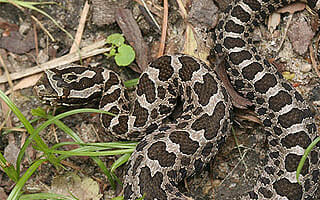 Since 2009, the DZS has coordinated the Eastern Massasauga Rattlesnake SSP® with Northern Illinois University and several zoos to determine abundance and establish a long-term monitoring program for these rattlesnakes in southwest Michigan. In addition, eastern massasauga rattlesnakes at the HRCC are part of a captive breeding program with partner institutions to build an assurance population. Eastern massasauga rattlesnakes are listed as a species of Special Concern by the Michigan Department of Natural Resources, and they are protected by state law. The program also includes the development of educational materials about massasauga rattlesnakes for zoos and nature centers in Michigan, Wisconsin, and Ohio to help people understand that massasaugas are not as venomous as other rattlesnakes and in fact provide beneficial services like controlling rodent populations.
Since 2009, the DZS has coordinated the Eastern Massasauga Rattlesnake SSP® with Northern Illinois University and several zoos to determine abundance and establish a long-term monitoring program for these rattlesnakes in southwest Michigan. In addition, eastern massasauga rattlesnakes at the HRCC are part of a captive breeding program with partner institutions to build an assurance population. Eastern massasauga rattlesnakes are listed as a species of Special Concern by the Michigan Department of Natural Resources, and they are protected by state law. The program also includes the development of educational materials about massasauga rattlesnakes for zoos and nature centers in Michigan, Wisconsin, and Ohio to help people understand that massasaugas are not as venomous as other rattlesnakes and in fact provide beneficial services like controlling rodent populations.
Siamese Crocodile SSP®
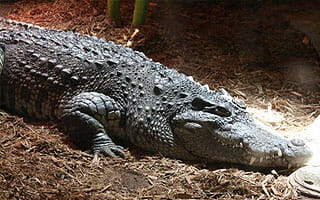 Siamese crocodiles formerly occurred over much of Southeast Asia. However, growing human populations have destroyed much of their habitat, and their current distribution is greatly fragmented. Siamese crocodiles are also threatened by over-hunting, and they are now the world’s second most endangered crocodile. As part of the Siamese Crocodile SSP®, 11 individuals hatched at the HRCC in 2015 are part of an ongoing reintroduction program to restore and bolster wild populations in protected areas of Southeast Asia.
Siamese crocodiles formerly occurred over much of Southeast Asia. However, growing human populations have destroyed much of their habitat, and their current distribution is greatly fragmented. Siamese crocodiles are also threatened by over-hunting, and they are now the world’s second most endangered crocodile. As part of the Siamese Crocodile SSP®, 11 individuals hatched at the HRCC in 2015 are part of an ongoing reintroduction program to restore and bolster wild populations in protected areas of Southeast Asia.
Aruba Island Rattlesnake SSP®
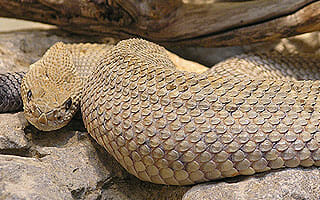 The Aruba Island rattlesnake is native to the Island of Aruba in the southern Caribbean Sea near Venezuela. Habitat degradation, especially for tourism development, has reduced the Aruba Island rattlesnake population to fewer than approximately 200 individuals in the wild, and it is considered critically endangered. The DZS provides financial support to the Aruba Island Rattlesnake SSP® to help restore habitat on Aruba, and as part of the SSP®, Aruba rattlesnakes are often housed at the HRCC.
The Aruba Island rattlesnake is native to the Island of Aruba in the southern Caribbean Sea near Venezuela. Habitat degradation, especially for tourism development, has reduced the Aruba Island rattlesnake population to fewer than approximately 200 individuals in the wild, and it is considered critically endangered. The DZS provides financial support to the Aruba Island Rattlesnake SSP® to help restore habitat on Aruba, and as part of the SSP®, Aruba rattlesnakes are often housed at the HRCC.
Turtle Survival Alliance
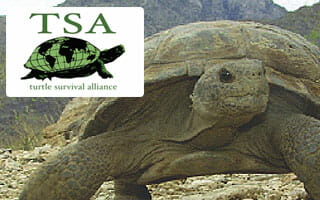 The Detroit Zoological Society provides financial support for biologists working with the Turtle Survival Alliance (TSA) to protect and study turtles and tortoises in India, Southeast Asia, Africa and South America. Turtle and tortoise populations in many countries are facing a crisis due to habitat destruction, trapping for the worldwide captive turtle trade and hunting for sale in Asian food markets, and it is estimated that as many as 10,000 turtles are disappearing from the wild each day. In Myanmar (Burma), for example, TSA confiscates and rehabilitates turtles and tortoises bound for Chinese markets. Then, TSA develops captive assurance populations and when populations are large enough they release individuals back to the wild. The TSA works to conserve a number of species that are also at the Holden Reptile Conservation Center such as Burmese star tortoises, Indian star tortoises, pancake tortoises, Egyptian tortoises and South African bowsprit tortoises.
The Detroit Zoological Society provides financial support for biologists working with the Turtle Survival Alliance (TSA) to protect and study turtles and tortoises in India, Southeast Asia, Africa and South America. Turtle and tortoise populations in many countries are facing a crisis due to habitat destruction, trapping for the worldwide captive turtle trade and hunting for sale in Asian food markets, and it is estimated that as many as 10,000 turtles are disappearing from the wild each day. In Myanmar (Burma), for example, TSA confiscates and rehabilitates turtles and tortoises bound for Chinese markets. Then, TSA develops captive assurance populations and when populations are large enough they release individuals back to the wild. The TSA works to conserve a number of species that are also at the Holden Reptile Conservation Center such as Burmese star tortoises, Indian star tortoises, pancake tortoises, Egyptian tortoises and South African bowsprit tortoises. -
Invertebrate Conservation
Partula Snail
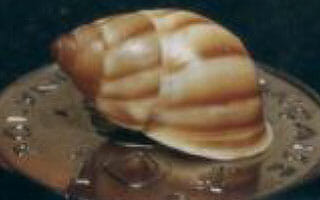 Partula snails are a group of small tree snails, approximately one-half to three-quarters of an inch in length. Their shells feature grey or brown spirals sometimes marked with white. Found on the Polynesian islands in the South Pacific including Tahiti, these shells were once used to make jewelry and to decorate Polynesian ceremonial garments. Partula snails are of great interest to science because they have adapted into a remarkable variety of species utilizing different habitats on different Polynesian islands.
Partula snails are a group of small tree snails, approximately one-half to three-quarters of an inch in length. Their shells feature grey or brown spirals sometimes marked with white. Found on the Polynesian islands in the South Pacific including Tahiti, these shells were once used to make jewelry and to decorate Polynesian ceremonial garments. Partula snails are of great interest to science because they have adapted into a remarkable variety of species utilizing different habitats on different Polynesian islands.On Tahiti, Partula snails have been nearly wiped out because of a botched attempt at what is known as “biological control”. Giant African land snails, a large African species of snail, were introduced to Tahiti to be a source of food for local people. The African snails did so well in Tahiti that they became a serious threat to farmers’ crops, and a predatory snail, the Florida rosy wolf snail, was brought to Tahiti to eat the African snails and control their numbers. The wolf snails also ate Partula snails and caused four of the eight Partula species to become extinct in the wild.
One of those species, Partula nodosa, was saved from complete extinction and sent to zoos. The Detroit Zoo was one of a small handful of zoos keeping these snails and at one point, all the Partula snails in the world lived at the Detroit Zoo. The Detroit Zoological Society (DZS) now participates in a global program, the Partula Programme Consortium, which manages a captive breeding program at zoos in the United Kingdom, France and the United States. One hundred snails were released back to Tahiti in the summer of 2015, and another 60 snails were released in 2016. In 2018, an additional 80 snails were sent to Artis Zoo in the Netherlands for eventual release to Tahiti. The DZS maintains a colony of Partula nodosa for future releases.
-
Environmental Emergency Response
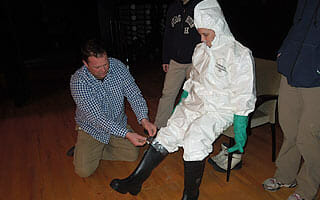 A number of Detroit Zoological Society (DZS) staff complete annual recertification in a HAZWOPER (Hazardous Waste and Emergency Response) 24-Hour Emergency Response Technician Program. This training allows staff to respond to environmental emergencies and assist with oil spill rehabilitation and recovery with various species of birds, reptiles, and mammals.
A number of Detroit Zoological Society (DZS) staff complete annual recertification in a HAZWOPER (Hazardous Waste and Emergency Response) 24-Hour Emergency Response Technician Program. This training allows staff to respond to environmental emergencies and assist with oil spill rehabilitation and recovery with various species of birds, reptiles, and mammals.
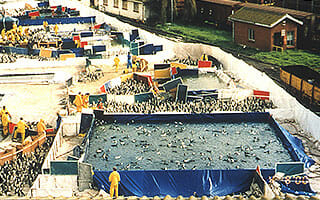 In June 2000, the oil freighter Treasure sank off the coast of Cape Town, South Africa, spilling 1,300 tons of fuel oil. The spill occurred near the largest and third largest colonies of African penguins affecting forty percent of the penguin population, and approximately 19,000 of the birds had oiled feathers. DZS animal care staff flew to South Africa to help with the rehabilitation process – cleaning and air-lifting the birds several miles up the coast for release. In addition, 3,300 abandoned chicks were reared and released.
In June 2000, the oil freighter Treasure sank off the coast of Cape Town, South Africa, spilling 1,300 tons of fuel oil. The spill occurred near the largest and third largest colonies of African penguins affecting forty percent of the penguin population, and approximately 19,000 of the birds had oiled feathers. DZS animal care staff flew to South Africa to help with the rehabilitation process – cleaning and air-lifting the birds several miles up the coast for release. In addition, 3,300 abandoned chicks were reared and released.
 In April 2010, the Deepwater Horizon oil spill happened in the Gulf of Mexico. This was the largest marine oil spill in history, and at times an estimated 2.2 million gallons of crude oil per day were leaking into the Gulf of Mexico. This oil spill affected 400 different species of wildlife, including 8,000 individual birds, 1,100 sea turtles and 109 mammals. The Detroit Zoological Society animal care staff worked with the Audubon Nature Institute providing medical care for 140 juvenile sea turtles.
In April 2010, the Deepwater Horizon oil spill happened in the Gulf of Mexico. This was the largest marine oil spill in history, and at times an estimated 2.2 million gallons of crude oil per day were leaking into the Gulf of Mexico. This oil spill affected 400 different species of wildlife, including 8,000 individual birds, 1,100 sea turtles and 109 mammals. The Detroit Zoological Society animal care staff worked with the Audubon Nature Institute providing medical care for 140 juvenile sea turtles.
-
Conservation Education Initiatives
CONAPAC
 The Civil Association for Conservation of the Peruvian Amazon Environment (CONAPAC) was formed in 1990 by a group of teachers, forestry engineers, and eco-tour operators to conserve the Peruvian Amazon primary rainforest by promoting education in remote forest communities. In 1999, the Detroit Zoological Society (DZS) volunteered to be the official CONAPAC Adopt-A-School sponsor in the United States. Not only does the DZS collect funding from all over the world to make the program possible, it also helps deliver school supplies to the villages. The Amazon Rainforest Adopt-A-School Program could not function without the tireless organizing, promoting, and marketing of the DZS staff. The DZS is also an important donor to CONAPAC’s programs, providing funds for books, teacher workshops, and project oversight. A brief movie illustrates the work of DZS with CONAPAC in Peru. If you want to contribute to the Adopt-A-School Program, please visit www.conapac.org.
The Civil Association for Conservation of the Peruvian Amazon Environment (CONAPAC) was formed in 1990 by a group of teachers, forestry engineers, and eco-tour operators to conserve the Peruvian Amazon primary rainforest by promoting education in remote forest communities. In 1999, the Detroit Zoological Society (DZS) volunteered to be the official CONAPAC Adopt-A-School sponsor in the United States. Not only does the DZS collect funding from all over the world to make the program possible, it also helps deliver school supplies to the villages. The Amazon Rainforest Adopt-A-School Program could not function without the tireless organizing, promoting, and marketing of the DZS staff. The DZS is also an important donor to CONAPAC’s programs, providing funds for books, teacher workshops, and project oversight. A brief movie illustrates the work of DZS with CONAPAC in Peru. If you want to contribute to the Adopt-A-School Program, please visit www.conapac.org.





